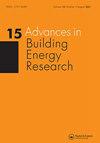An investigation of thermal comfort, IAQ, and energy saving in UFAD systems using a combination of Taguchi optimization algorithm and CFD
IF 2.5
Q2 CONSTRUCTION & BUILDING TECHNOLOGY
引用次数: 7
Abstract
ABSTRACT The present study investigates underfloor air distribution (UFAD) systems by using the combination of computational fluid dynamics (CFD) and the Taguchi optimization algorithm. A multi-objective optimization approach is used to analyze the efficiency of UFAD systems from the viewpoints of thermal comfort, indoor air quality (IAQ), and energy consumption. The supply air temperature, the air change rate per hour (ACH), and the height of the return air vent factors are considered in order to achieve the optimum operating condition. First, numerical validation has been done for an office room model, and then optimization has been performed for this space. The optimization results state that setting the supply air temperature and ACH at 19°C and 4.0, respectively, and placing the return air vent at the height of 1.6 m would lead to the optimum state. The CFD simulation results for this condition show that the thermal comfort in the occupied zone and the desirable IAQ in the breathing zone are established, corresponding to the predicted mean vote (PMV) and mean age of air (MAA) values equal to 0.13 and 640 s, respectively. Furthermore, energy consumption has a considerable reduction of 21.5%, compared to the conventional mixing ventilation (MV) systems.结合田口优化算法和CFD对UFAD系统的热舒适、室内空气质量和节能进行了研究
摘要本研究采用计算流体力学(CFD)和田口优化算法相结合的方法研究了地板下空气分配(UFAD)系统。采用多目标优化方法,从热舒适性、室内空气质量和能耗的角度分析了UFAD系统的效率。为了达到最佳运行条件,考虑了送风温度、每小时换气率(ACH)和回风口高度因素。首先,对一个办公室模型进行了数值验证,然后对该空间进行了优化。优化结果表明,将送风温度和ACH分别设置为19°C和4.0,并将回风通风口设置在1.6的高度 m将导致最佳状态。该条件下的CFD模拟结果表明,占用区的热舒适性和呼吸区的理想IAQ已经建立,对应于0.13和640的预测平均投票率(PMV)和平均空气年龄(MAA)值 s、 分别。此外,与传统的混合通风(MV)系统相比,能耗显著降低了21.5%。
本文章由计算机程序翻译,如有差异,请以英文原文为准。
求助全文
约1分钟内获得全文
求助全文
来源期刊

Advances in Building Energy Research
CONSTRUCTION & BUILDING TECHNOLOGY-
CiteScore
4.80
自引率
5.00%
发文量
11
 求助内容:
求助内容: 应助结果提醒方式:
应助结果提醒方式:


